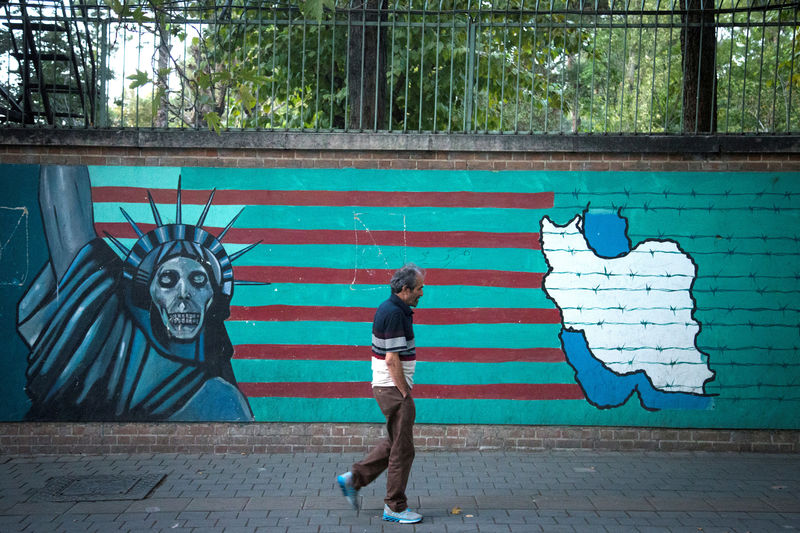(Bloomberg Opinion) -- With the Islamic Republic announcing that it has breached uranium-enrichment limits agreed in the 2015 nuclear deal, let’s take a quick trip down memory lane, to remind ourselves of how we got here.
The first thing to keep in mind—and it is often forgotten—is that Iran has only ever had one reason to start a nuclear program: to menace its neighbors. This was true for Shah Mohammed Reza Pahlavi in the 1950s, and it is true of the theocratic state that has followed.
In 1974, in a moment of rare candor, the Shah admitted he wanted nuclear bombs. Iran’s current rulers have been careful not to declare their intention: they say it has more to do with proving Iran’s scientific prowess, and with a view to one day producing nuclear energy, but not for military applications. Indeed, Iranian officials have claimed that Supreme Leader Ali Khamenei issued a fatwa against nuclear weapons.
This protestation is problematic in many ways. Sitting on some of the world’s most abundant supplies of oil and natural gas, Iran has no need for nuclear energy. (This is also true of Saudi Arabia, which is pursuing nuclear technology.) It is not expending comparable state resources on other alternative energy technologies, like solar or wind power.
And the excuse that Iran wanted to show off its scientific capabilities doesn’t wash. These days, nuclear technology is no indication of great technical accomplishment: as North Korea has demonstrated, pretty much any country that sets itself to develop the technology can do so, if it is prepared to brave international opprobrium, and sanctions.
The only logical reason for Iran to have a nuclear program was to signal to its Arab neighbors that the theocracy was capable, at least in theory, of building the ultimate weapon. It is no accident that the nuclear program accelerated after the 1980-88 Iran-Iraq war. The regime in Tehran, still isolated from much of the world, needed anything—even a theoretical nuclear threat—to avert a repeat of that disastrous conflict.
But as the Iraqi threat receded in the 1990s, the Iranians began to expand their influence in the Arab world, typically by deepening ties with terrorist groups—like Hezbollah in Lebanon, and Hamas in Gaza. During this period, the regime kept up the charade that its nuclear program was small, and entirely benign.
But there were actually two Iranian nuclear programs. The second was conducted in utmost secrecy, until it was revealed in 2002, when a uranium-enrichment facility at Natanz and a heavy-water facility in Arak came to light. With Russian help, Iran had been pursuing nukes after all. So much for Khamenei’s fatwa.
Caught out in its lie, Iran suspended its quest for nuclear weapons in 2003, but continued enrichment. The message to its neighbors remained unchanged: we’re only a few steps away from having the capacity to make the Bomb. Meanwhile, Iran continued to perpetrate mischief through its proxies.
The world reacted by placing Iran under sanctions: the United Nations in 2006 and 2010, before the Western powers imposed even more restrictions in 2011 and in the years that followed. Iran remained defiant even as its economy atrophied, and its currency tumbled.
Finally, in 2013, the regime signaled an openness to negotiations. Khamenei, channeling George Orwell, described this U-turn as an act of “heroic flexibility.”
Two years of complex negotiations followed, between Iran and the world powers—the U.S., the EU, Germany, Russia, China, France and Britain. The discussions centered on the nuclear program, and not on Iran’s other malign activities. Eventually, they came up with the 2015 Joint Comprehensive Plan of Action, which restrained the nuclear program for 15 years. In exchange, Iran was to re-enter the global financial system, increase oil and gas exports, and access as much as $150 billion in frozen assets.
The Obama administration declared the deal a great bargain, an end to Iran’s history of nuclear deceit. For its neighbors, it was a disaster, giving the regime a shield from behind which it could continue to menace them. They feared that access to billions of dollars in unfrozen assets and new revenues would allow the Iranian regime to fund ever more ambitious efforts to destabilize the region. And indeed, the Islamic Republic significantly increased its support for its proxies and allies.
The biggest beneficiary was the Syrian dictator Bashar al-Assad, with Iranian fighters and proxies joining in his genocide against the country’s Sunni majority population. For good measure, the regime also stepped up assassinations of opponents on European soil.
Last year, President Trump pulled the U.S. out of the deal, and began imposing tighter sanctions, re-designating the Islamic Revolutionary Guard Corps as a terrorist group, and sanctioning Khamenei himself. But what the Trump administration hopes to achieve is unclear—simply a better nuclear deal than the JCPOA, or a grand bargain incorporating all of Iran’s chronic misbehavior.
Now, apparently giving up hope that the other JCPOA signatories can help it evade the sanctions, Iran says it will gradually abandon the nuclear restraints it agreed to in 2015. The days ahead will see debates about how much enrichment amounts to an actual threat. Should we start worrying when Iran has 1,000 kg of uranium enriched to 3.67%? Or can we remain sanguine until they begin enrichment to 20%?
The Iranians will likely remain—or at least give the impression of remaining—within enrichment levels that allow them to claim they’re not actually trying to make nuclear weapons. But remember: there is no other reason for them to have a nuclear program.
